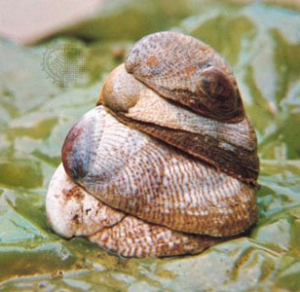
Snails Family gastropodia
Snail Menu
Snails
Snail Anatomy
Mud Dog Whelk (Mud Snail)
Moon Snails
Radula
Slipper Shell
Oyster Drill
Murex Snails

Gastropoda Latin: gaster=stomach podus=foot
Atlantic Slipper Shell Crepidula fornicata
The Atlantic slipper shell is a marine snail that grows to approximately 1 to 2.5 inches in length.
 In the bay they attach to almost any solid object.
In the bay they attach to almost any solid object.
They are often found attached to moon snails, mussels, bay scallops, and Atlantic horseshoe crabs.
They will also attach themselves to boat bottoms, dock pilings and discarded trash (like the beer bottle in the image to the right).
Slipper shells also form stacked aggregations when there is no hard substrate on which to attach
Using their strong ‘foot’ they can remain in one place attached to a substrate while taking advantage of the tidal currents for food.
To feed they relax their foot, open a gap between whatever they are attached to (including other slipper shells) to and their shell.
Cilia aid the water flow bring in whatever is in the water column.
Common slipper shells use their cilia to create water currents that flow through their mantle cavity.
They are filter feeders, and as the water passes through the cavity, mucous-covered gills trap various types of phytoplankton and algae.
It then uses its radula to remove the food and bring it to its mouth.
<learn more about the radula>
 Slipper Shells snails are mobile males in the beginning of their life and change into sessile females at a later time.
Slipper Shells snails are mobile males in the beginning of their life and change into sessile females at a later time.
The spectacular mating “ladders” of slipper shells come into existence, when younger males sit on older females to mate with them, with even younger males mating with them later, when they are female.
If the female at the bottom of the “stack” dies, the lowest male will become the female.




